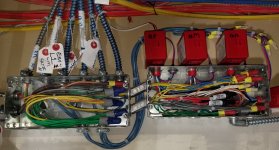- Location
- New Jersey
- Occupation
- Journeyman Electrician (retired)
I saw this on a job where the 0-10 volt wiring was brought out of the junction box and spliced. Doesn't class 1 wiring need to be within the box? I was told that some inspector didn't want those splices within the box. My argument was that on the other end in the fixture they're all spliced in the same junction box so what did this accomplish?



